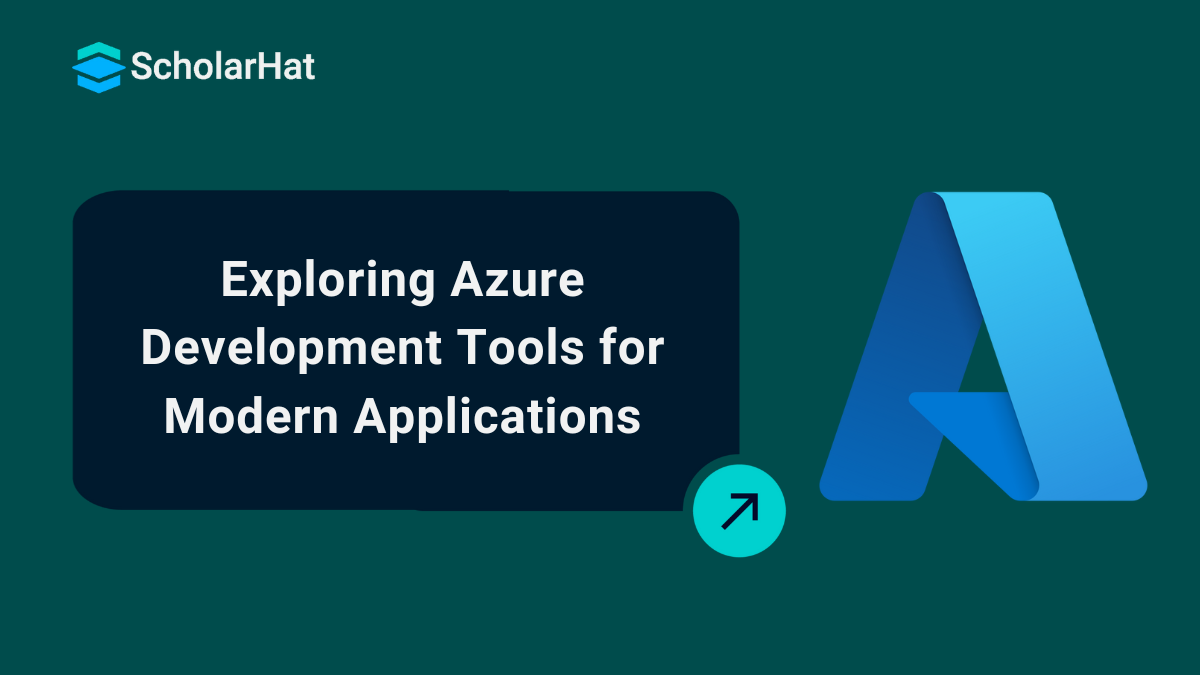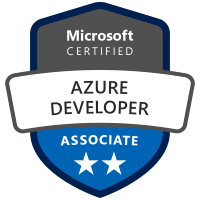18
AprTop Azure Development Tools: A Complete Guide for Developers in 2025
Azure Development Tools provide everything you need to build, test, and deploy applications on Microsoft Azure. Whether you're a developer, tester, or DevOps engineer, tools like Azure DevOps, Visual Studio, GitHub Actions, and Azure SDKs help streamline development. These tools support multiple programming languages, making it easy to create scalable and secure cloud applications.
In this Azure tutorial, I’ll walk you through the essential Azure Development Tools, their features, and how you can use them to enhance your cloud development workflow. Ready to boost your Azure development skills? Let’s dive in!
Why Use Azure Development Tools?
Azure development tools make it easy to build, deploy, and manage applications. They work smoothly with Azure services, ensuring high performance, scalability, and security. Whether you're working with web apps, AI, or cloud-native solutions, these tools simplify your development process.
1. Seamless Integration with Azure Services
Azure tools connect effortlessly with services like Azure Functions, Kubernetes, and AI models. You can automate deployments using Azure DevOps and GitHub Actions, making your workflow faster and smoother.
2. Scalability and Performance
Your applications need to handle growing traffic. With features like autoscaling and managed databases, Azure ensures they stay responsive. Services like Azure App Service and SQL Database help maintain top performance under heavy loads.
3. Multi-Language Support
Azure supports languages like C#, Java, Python, and JavaScript. With tools like Visual Studio and VS Code, coding becomes more efficient, boosting productivity and reducing development time.
4. Security and Compliance
Security is essential. Azure offers built-in tools like Security Center and Defender to protect your applications. It also meets industry compliance standards, helping you stay secure and compliant.
5. Cloud-Native Development
Building cloud-native applications is easier with Container Apps and Kubernetes. With Azure Functions, you can develop serverless applications without worrying about infrastructure.
6. AI and Machine Learning Integration
Want to add AI to your applications? Azure provides Azure OpenAI and Cognitive Services, making it simple to deploy machine learning models at scale.
| Read More: How ChatGPT, OpenAI, and Azure OpenAI Work Together |
7. Cost Optimization
Azure’s flexible pricing means you only pay for what you use. With cost management tools, you can monitor and optimize your cloud spending.
Top Azure Development Tools
Azure offers powerful tools to help you develop, deploy, and manage applications efficiently. These tools automate workflows, improve productivity, and integrate seamlessly with Azure services, making cloud development easier and more scalable. Let’s explore the top Azure development tools and their key features.
1. Azure DevOps
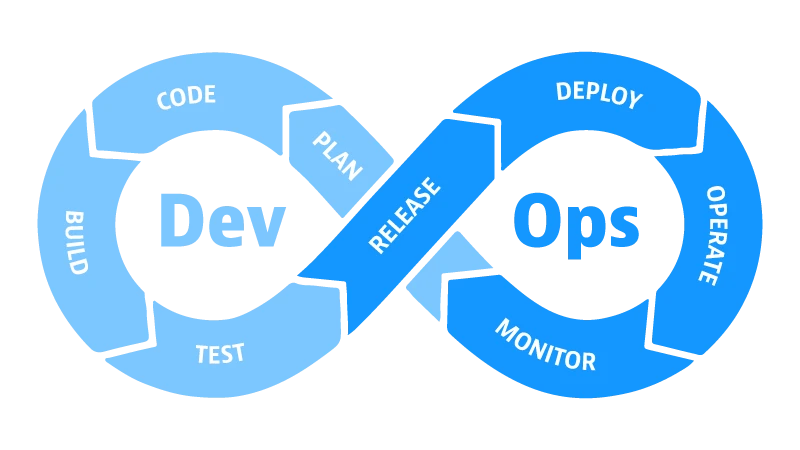
Azure DevOps is an all-in-one platform that helps you collaborate, automate deployments, and manage projects using Agile methodologies.
Features:
- CI/CD Pipelines: Automates building, testing, and deploying applications, reducing manual effort.
- Git Repositories: Provides Azure Repos, a secure and scalable version control system supporting Git and TFVC.
- Agile Planning and Tracking: Offers Kanban boards, sprint planning, and backlog management.
- Integration with Third-Party Tools: Works with Jenkins, GitHub, Terraform, and Kubernetes.
- Security and Compliance: Implements role-based access control (RBAC) and compliance policies.
2. Azure CLI
Azure CLI is a command-line interface that lets you manage Azure resources quickly through scripts and commands.
Features:
- Command-Based Management: Manage Azure services using simple command-line instructions.
- Automation and Scripting: Supports Bash, PowerShell, and Python for automating tasks.
- Cross-Platform Availability: Works on Windows, macOS, and Linux.
- Extensibility: Supports custom modules and plugins for additional functionality.
- Integration with CI/CD Pipelines: Automates deployments and resource provisioning.
3. Azure Resource Manager (ARM)
Azure Resource Manager (ARM) helps you deploy and manage resources using JSON-based templates.
Features:
- Declarative Resource Deployment: Uses ARM templates to provision infrastructure.
- Consistency Across Environments: Keeps development, testing, and production environments identical.
- Role-Based Access Control (RBAC): Ensures secure access management.
- Dependency Handling: Automatically provisions resources in the correct order.
- Centralized Management: Manages multiple resources in a single deployment.
4. Azure SDKs
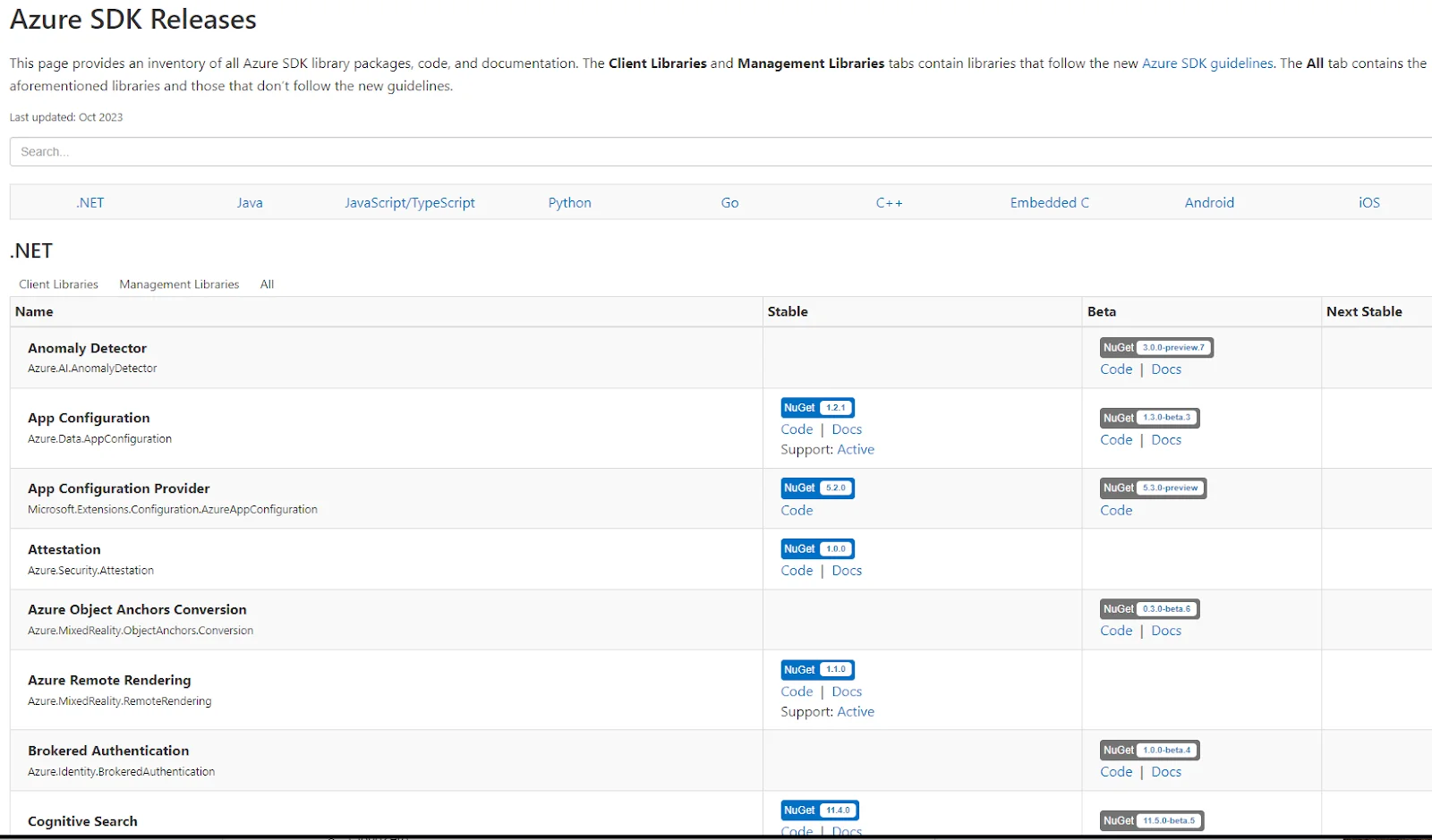
Azure SDKs provide libraries that make it easier to interact with Azure services in different programming languages.
Features:
- Multi-Language Support: Works with Python, Java, .NET, and JavaScript.
- Simplified API Calls: Offers easy-to-use methods for database connections and authentication.
- Built-In Security and Authentication: Integrates with Azure Active Directory (Azure AD).
- Cloud-Native Development: Helps build and deploy applications quickly.
- Continuous Updates and Improvements: Regular updates enhance features and security.
5. Azure Functions
Azure Functions is a serverless computing service that runs code in response to events, making automation and microservices development easier.
Features:
- Event-Driven Execution: Runs functions triggered by HTTP requests, storage events, or database changes.
- Automatic Scaling: Adjusts resources based on demand.
- Pay-Per-Execution Pricing Model: Charges only for execution time, reducing costs.
- Seamless Integration with Azure Services: Works with Event Grid, Logic Apps, and Service Bus.
- Multi-Language Support: Supports C#, Python, Java, JavaScript, and PowerShell.
6. Azure App Service
Azure App Service is a fully managed platform that simplifies web application and API deployment.
Features:
- Multi-Language and Framework Support: Supports .NET, Java, Python, PHP, Ruby, and Node.js.
- Built-In Security and Compliance: Provides SSL/TLS encryption and identity authentication.
- Automatic Scaling and Load Balancing: Adjusts resources to meet traffic demands.
- Continuous Deployment and Integration: Works with GitHub, Bitbucket, and Azure DevOps.
- Hybrid and On-Premises Connectivity: Allows secure connections to on-premises resources.
7. Azure Static Web Apps
Azure Static Web Apps makes it easy to deploy full-stack web applications with seamless integration of front-end and back-end services.
Features:
- Optimized for Static Sites: Works well with React, Angular, Vue.js, and Blazor.
- Seamless CI/CD Integration: Uses GitHub Actions for automated deployments.
- Serverless API Support: Integrates with Azure Functions for dynamic back-end functionality.
- Global Content Delivery: Uses Azure CDN for fast loading speeds.
- Authentication and Authorization: Supports Azure AD, GitHub, and social logins.
AI & Machine Learning Tools
Azure provides powerful AI and machine learning tools that help you build intelligent applications with ease. Whether you need pre-built AI models, machine learning automation, or chatbot development, Azure has the right tool for you. Let’s explore some of the top AI and machine learning tools available in Azure.
| Read More: ChatGPT vs DeepSeek |
1. Azure Machine Learning
Azure Machine Learning is a complete platform that helps you train, deploy, and manage machine learning models efficiently.
Features:
- End-to-End ML Platform: Supports the entire machine learning lifecycle, from data preparation to deployment.
- Automated ML: Speeds up model training by automatically selecting the best algorithms and hyperparameters.
- MLOps Integration: Ensures smooth model deployment and monitoring with CI/CD pipelines.
- Scalability: Runs models on cloud-based GPUs and distributed computing for high-performance training.
- Responsible AI: Provides tools for fairness, interpretability, and security in AI models.
2. Azure Cognitive Services
Azure Cognitive Services offers pre-built AI models that enable applications to see, hear, speak, and understand language.
Features:
- Vision AI: Analyzes images, recognizes objects, and extracts text using Computer Vision and Face API.
- Speech AI:Natural Language Processing in AI Converts speech to text, translates languages, and generates natural-sounding voices.
- Language AI: Processes and understands text using Text Analytics, Translator, and QnA Maker.
- Decision AI: Enhances decision-making with AI models like Anomaly Detector and Personalizer.
- Seamless API Integration: Easily integrates with existing applications for AI-powered experiences.
3. Azure Bot Services
Azure Bot Services allows you to build, deploy, and manage AI-driven chatbots effortlessly.
Features:
- No-Code and Low-Code Development: Create bots easily with a visual designer or integrate with Bot Framework SDK.
- AI-Powered Conversations: Uses Azure Cognitive Services for natural language understanding (NLU).
- Multi-Channel Deployment: Deploy bots across Microsoft Teams, Slack, Facebook Messenger, and websites.
- Speech and Text-Based Interactions: Enables voice and text communication using AI-driven responses.
- Built-In Analytics: Monitors bot performance with real-time analytics and insights.
4. Azure OpenAI Service
Azure OpenAI Service provides access to powerful AI models like GPT to build intelligent and conversational applications.
Features:
- Access to GPT Models: Leverages state-of-the-art AI for text generation, summarization, and language understanding.
- AI-Powered Chatbots: Creates conversational AI experiences with human-like responses.
- Code Generation: Helps developers write and optimize code using AI suggestions.
- Content Moderation: Detects harmful or inappropriate content with built-in AI filters.
- Enterprise-Grade Security: Ensures data privacy and compliance with Azure security standards.
Looking to integrate AI into your applications? Azure makes it easier than ever to build smart, scalable, and efficient solutions!
| Read More: Azure Security Certification (AZ-500) |
Containerization & Orchestration Tools
Azure provides powerful containerization and orchestration tools to help you deploy, manage, and scale containerized applications efficiently. Whether you need a fully managed Kubernetes service, serverless containers, or a hybrid cloud solution, Azure has the right tool for your needs.
1. Azure Kubernetes Service (AKS)
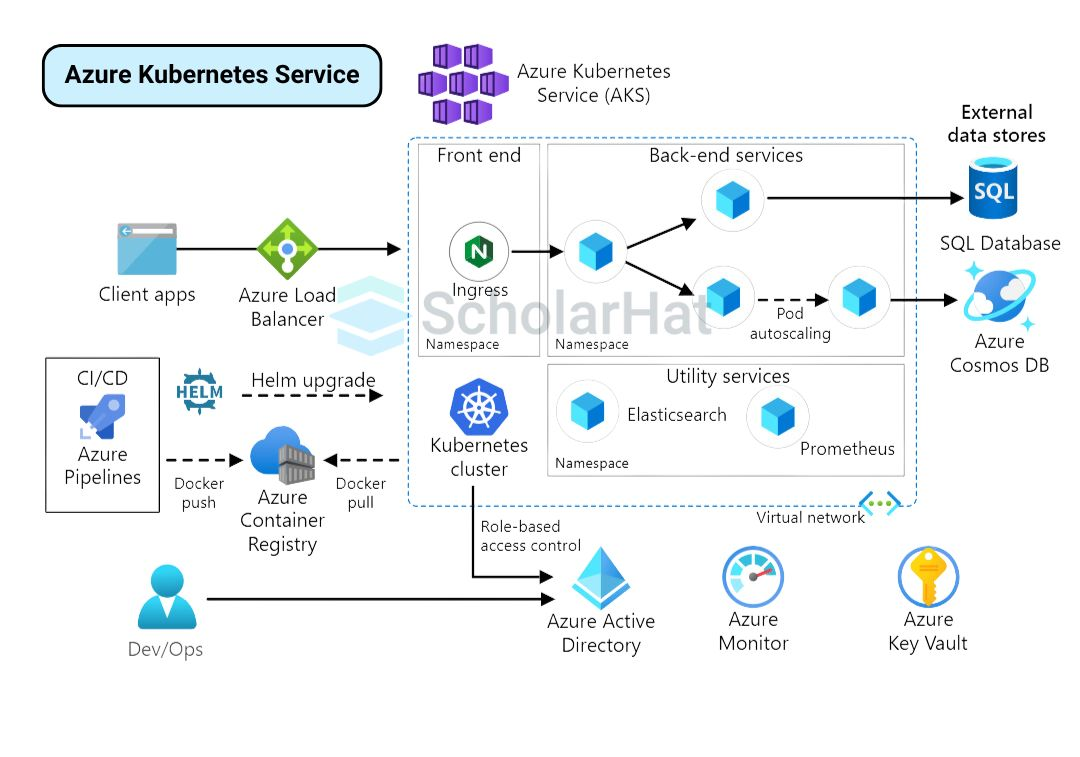
Azure Kubernetes Service (AKS) is a managed Kubernetes service that simplifies containerized application deployment, scaling, and management.
Features:
- Fully Managed Kubernetes: Reduces operational overhead with automatic updates, scaling, and monitoring.
- Built-In Security: Integrates with Azure Active Directory (Azure AD), role-based access control (RBAC), and network policies.
- CI/CD Integration: Works seamlessly with Azure DevOps and GitHub Actions for automated deployments.
- Auto-Scaling: Adjusts resources dynamically based on workload demand.
- Multi-Cloud and Hybrid Support: Runs workloads across on-premises, hybrid, and multi-cloud environments.
2. Azure Container Instances (ACI)
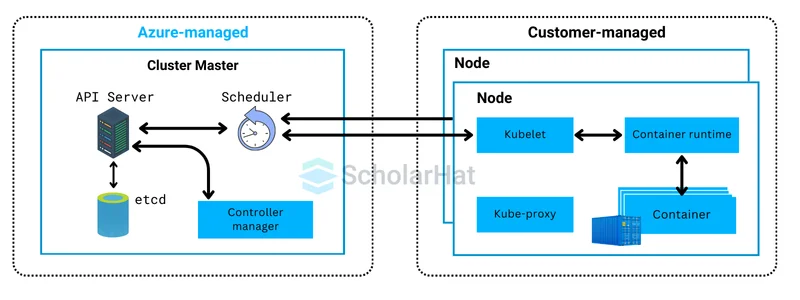
Azure Container Instances (ACI) lets you run containers without provisioning or managing virtual machines, making it ideal for quick deployments.
Features:
- Serverless Containers: Deploy containers instantly without worrying about infrastructure management.
- Per-Second Billing: Pay only for the exact CPU and memory used by your containers.
- Rapid Scaling: Start and stop containers within seconds to handle workload spikes.
- Secure by Default: Supports virtual network integration for isolated container execution.
- Works with Kubernetes: Easily integrates with AKS for additional computing capacity.
3. Azure Service Fabric
Azure Service Fabric is a container orchestration and microservices platform designed for large-scale distributed applications.
Features:
- Microservices Architecture: Runs stateful and stateless microservices efficiently.
- High Availability: Ensures fault tolerance with automatic failover and self-healing capabilities.
- Multi-Language Support: Develops services using .NET, Java, Node.js, and C++.
- Flexible Deployment: Deploys applications on Azure, on-premises, or hybrid cloud environments.
- Built-In Monitoring: Provides deep insights into performance and health metrics.
4. Azure Red Hat OpenShift
Azure Red Hat OpenShift is an enterprise-grade Kubernetes solution that provides a managed OpenShift platform for hybrid and multi-cloud deployments.
Features:
- Fully Managed OpenShift: Reduces operational complexity with automated updates and monitoring.
- Hybrid Cloud Support: Runs seamlessly across on-premises and public cloud environments.
- Integrated Developer Tools: Includes CI/CD pipelines, container registry, and monitoring solutions.
- Enterprise-Grade Security: Provides built-in compliance, encryption, and access control.
- Scalability: Supports auto-scaling for workloads with fluctuating demand.
Looking to simplify your containerized workloads? Azure provides the best tools to deploy, manage, and scale your applications effortlessly.
Database & Storage Management Tools
Azure offers powerful database and storage management tools to handle structured and unstructured data efficiently. Whether you need a globally distributed NoSQL database, a managed SQL solution, or a tool for big data processing, Azure provides the right services.
1. Azure Cosmos DB
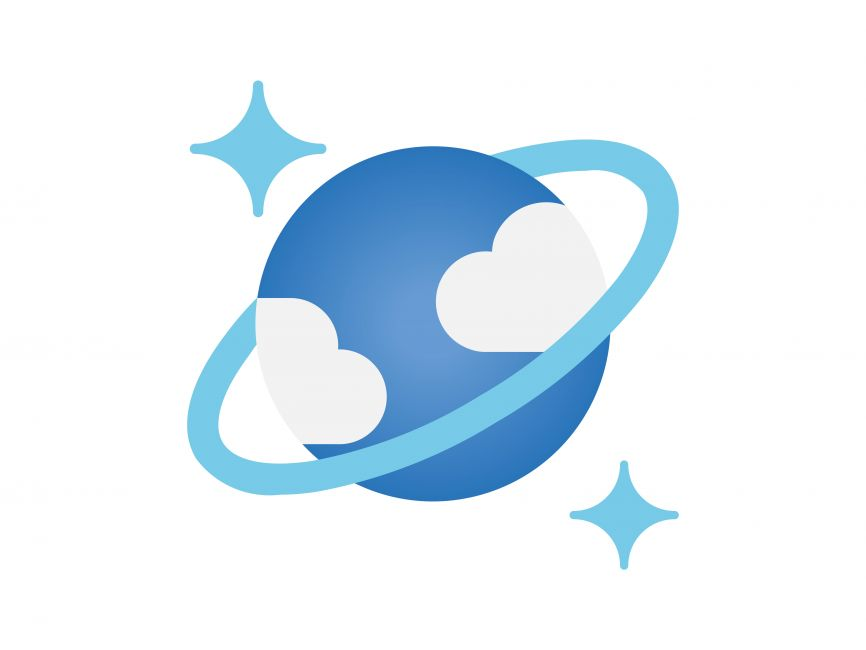
Azure Cosmos DB is a globally distributed NoSQL database designed for low-latency, high-availability applications.
Features:
- Multi-Model Support: Works with key-value, graph, column-family, and document-based data models.
- Global Distribution: Automatically replicates data across multiple regions for high availability.
- Guaranteed Speed: Provides single-digit millisecond response times.
- Auto-Scaling: Adjusts throughput based on real-time demand.
- Integrated Security: Supports RBAC, encryption, and private links for secure data access.
2. Azure SQL Database
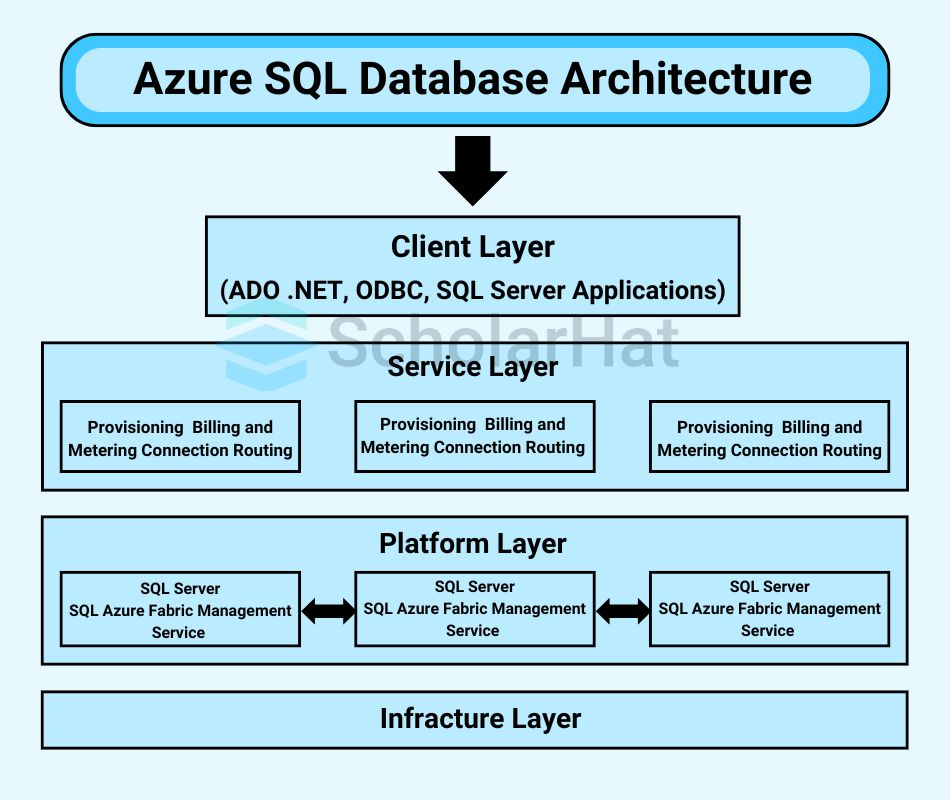
Azure SQL Database is a fully managed relational database service that ensures high performance and security.
Features:
- AI-Driven Optimization: Uses machine learning for automatic tuning and query performance improvement.
- Built-In Security: Offers threat detection, data encryption, and access control.
- Serverless and Hyperscale: Supports auto-scaling to handle workloads efficiently.
- High Availability: Provides 99.99% uptime with automatic backups.
- Seamless Integration: Works with Power BI, Azure Data Factory, and AI services for advanced analytics.
3. Azure Database for MySQL, PostgreSQL, and MariaDB
Azure Database offers managed services for open-source databases like MySQL, PostgreSQL, and MariaDB.
Features:
- Fully Managed: Reduces administrative effort with automated patching and backups.
- High Availability: Ensures 99.99% uptime with built-in redundancy.
- Performance Optimization: Uses AI-driven query performance insights.
- Security and Compliance: Supports advanced encryption, firewall rules, and identity management.
- Scalability: Allows easy scaling of compute and storage resources.
4. Azure Data Factory
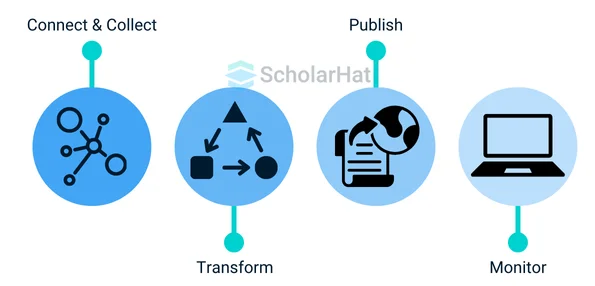
Azure Data Factory is a cloud-based ETL (Extract, Transform, Load) tool for big data integration and processing.
Features:
- Code-Free Data Integration: Provides a visual workflow editor for designing data pipelines.
- Connects to 90+ Data Sources: Supports databases, cloud storage, and on-premises systems.
- Scalability: Processes massive datasets using Azure Synapse Analytics.
- Real-Time Data Processing: Integrates with Azure Stream Analytics for real-time ETL.
- Security and Compliance: Uses Azure AD authentication and data masking.
5. Azure Storage Explorer
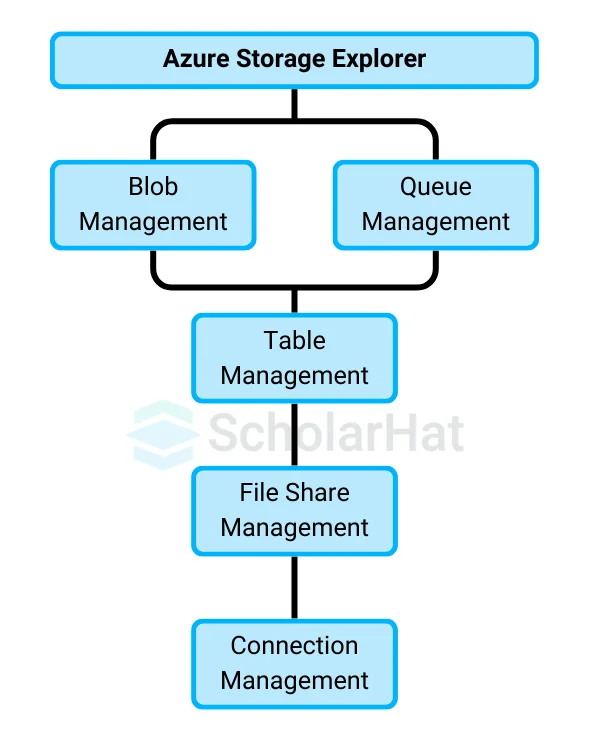
Azure Storage Explorer is a GUI tool for managing Azure storage services efficiently.
Features:
- Visual Management: Easily manage Blob, Queue, Table, and File storage from a single interface.
- Cross-Platform: Available for Windows, macOS, and Linux.
- Secure Access: Supports RBAC, shared access signatures (SAS), and Azure AD authentication.
- Offline Access: Allows downloading and managing data locally.
- Data Transfer: Simplifies large-scale data migration between on-premises and cloud storage.
Need reliable database and storage solutions? Azure provides scalable, secure, and high-performance tools to manage your data effortlessly.
API & Integration Tools
Azure offers powerful API and integration tools to help you connect, automate, and manage cloud and on-premises services seamlessly. These tools ensure secure communication between applications, enable event-driven architectures, and simplify data exchange.
1. Azure API Management
Azure API Management is a full-fledged API gateway that allows you to create, secure, and monitor APIs.
Features:
- API Gateway: Enables centralized management of all APIs, including third-party and internal services.
- Security & Authentication: Supports OAuth, JWT, and Azure AD for API access control.
- Traffic Management: Provides rate limiting, caching, and throttling to optimize performance.
- Analytics & Monitoring: Tracks API usage, response times, and error rates with built-in Azure Monitor integration.
- Multi-Environment Support: Deploy APIs across development, testing, and production environments effortlessly.
2. Azure Logic Apps
Azure Logic Apps helps you automate workflows by integrating cloud and on-premises services without writing complex code.
Features:
- Visual Workflow Designer: Drag-and-drop interface for creating business logic and automation.
- Over 400 Connectors: Easily integrate with Microsoft 365, Salesforce, SAP, and more.
- Event-Driven Triggers: Automate processes based on HTTP requests, database updates, or file uploads.
- Scalability: Handles high-volume workflows with built-in load balancing.
- Security & Compliance: Supports role-based access control (RBAC), encryption, and private networking.
3. Azure Event Grid
Azure Event Grid is a fully managed event-routing service that simplifies real-time event-driven architecture.
Features:
- Event-Driven Model: React to changes instantly using event notifications.
- Serverless Integration: Works seamlessly with Azure Functions, Logic Apps, and Kubernetes.
- Low Latency: Delivers events in milliseconds with high availability.
- Advanced Filtering: Route events based on specific criteria to reduce unnecessary processing.
- Security & Compliance: Uses Azure AD authentication, encryption, and private endpoints for data security.
4. Azure Service Bus
Azure Service Bus is a highly reliable message broker that helps decouple and scale applications.
Features:
- Reliable Messaging: Ensures asynchronous communication between applications, reducing dependency issues.
- FIFO & Pub/Sub Support: Supports message queuing and publish-subscribe models.
- Dead Letter Queue: Handles failed messages automatically for troubleshooting.
- Geo-Replication: Ensures high availability and disaster recovery.
- Security & Compliance: Supports Azure AD, encryption, and role-based access control (RBAC).
5. Azure Data Share
Azure Data Share enables secure and controlled data sharing between organizations.
Features:
- Secure Data Exchange: Shares data without transferring ownership.
- Automated Data Refresh: Keeps shared data updated in real-time.
- Access Control: Defines granular permissions for data recipients.
- Multi-Format Support: Works with structured, semi-structured, and unstructured data.
- Compliance & Governance: Ensures data security with Azure AD authentication and encryption.
Looking for seamless API integration and event-driven automation? Azure provides scalable tools to connect and manage your applications efficiently.
Security & Identity Management Tools
Azure provides powerful security and identity management tools to help you protect cloud environments, enforce compliance, and manage access control efficiently. These tools ensure threat detection, data encryption, and governance across your infrastructure.
1. Azure Security Center
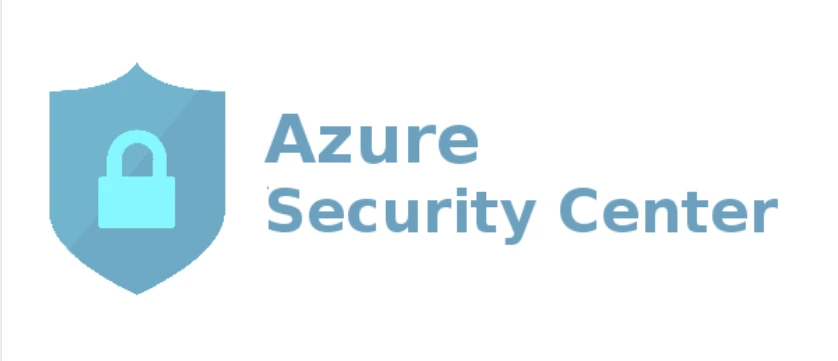
Azure Security Center is a centralized security management system that provides threat protection across your Azure and hybrid cloud workloads.
Features:
- Threat Detection & Response: Identifies vulnerabilities and provides real-time threat alerts.
- Security Recommendations: Offers actionable insights to improve security posture.
- Compliance Management: Ensures compliance with industry standards like ISO 27001, PCI-DSS, and NIST.
- Integration with Microsoft Defender: Extends security capabilities with advanced threat protection.
- Continuous Monitoring: Tracks security risks in real-time to prevent data breaches.
2. Microsoft Defender for Cloud
Microsoft Defender for Cloud provides advanced threat protection for Azure, on-premises, and multi-cloud environments.
Features:
- Cloud Security Posture Management (CSPM): Helps identify security misconfigurations across workloads.
- Advanced Threat Protection: Uses AI-powered analytics to detect suspicious activities.
- Secure DevOps: Integrates security into CI/CD pipelines to detect vulnerabilities early.
- Threat Intelligence: Provides insights into global cyber threats to strengthen defenses.
- Multi-Cloud Support: Protects AWS and Google Cloud workloads alongside Azure resources.
| Read More: AWS vs Azure vs Google Cloud |
3. Azure Active Directory (Azure AD)
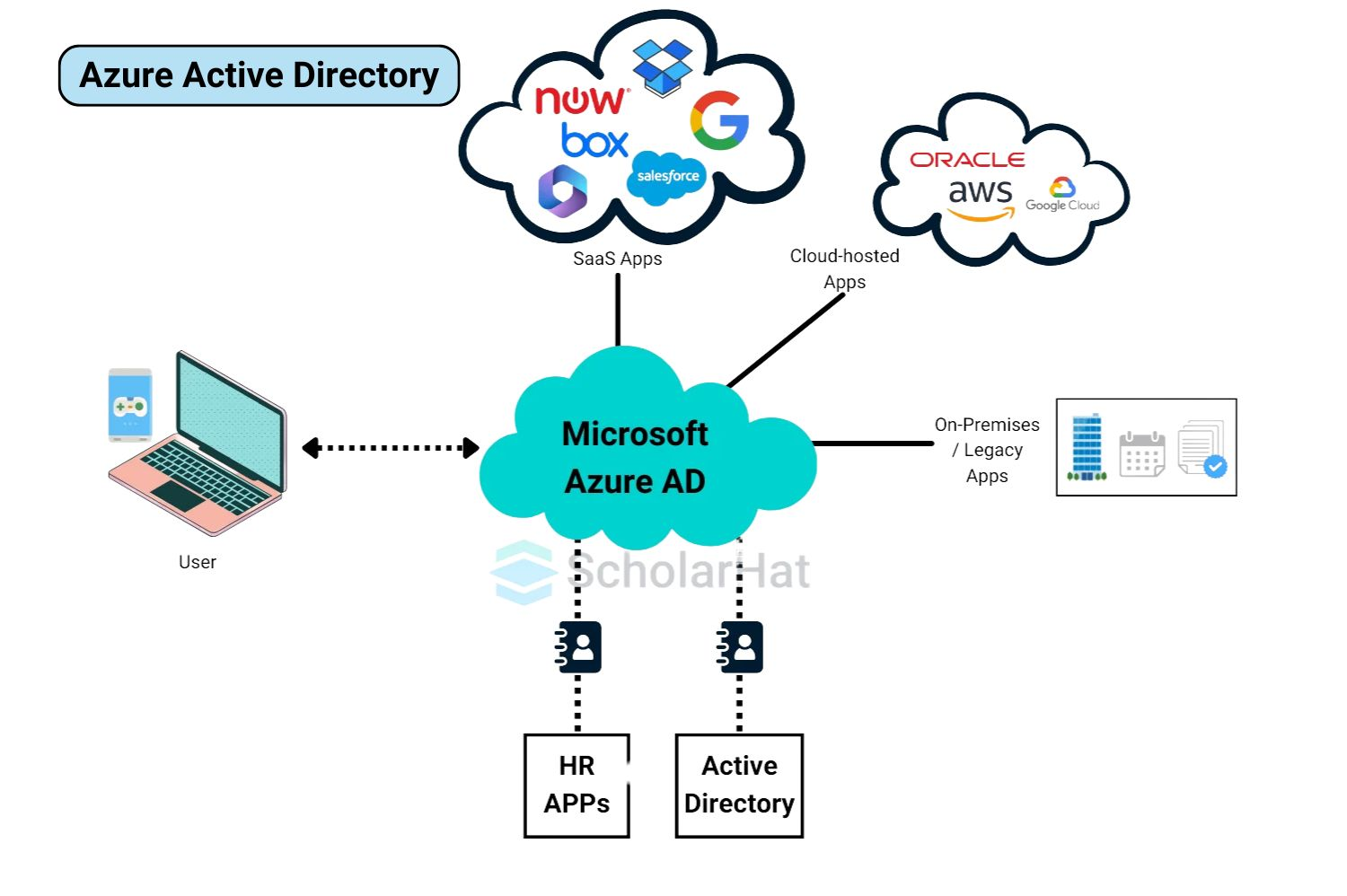
Azure Active Directory is a cloud-based identity and access management (IAM) service that secures user authentication and application access.
Features:
- Single Sign-On (SSO): Allows users to log in once and access multiple applications securely.
- Multi-Factor Authentication (MFA): Enhances security by requiring additional authentication steps.
- Conditional Access: Applies access policies based on device, location, and risk level.
- Identity Protection: Detects and mitigates identity-based threats in real-time.
- Integration with Microsoft 365 & SaaS Apps: Supports thousands of applications like Salesforce, Zoom, and SAP.
4. Azure Key Vault
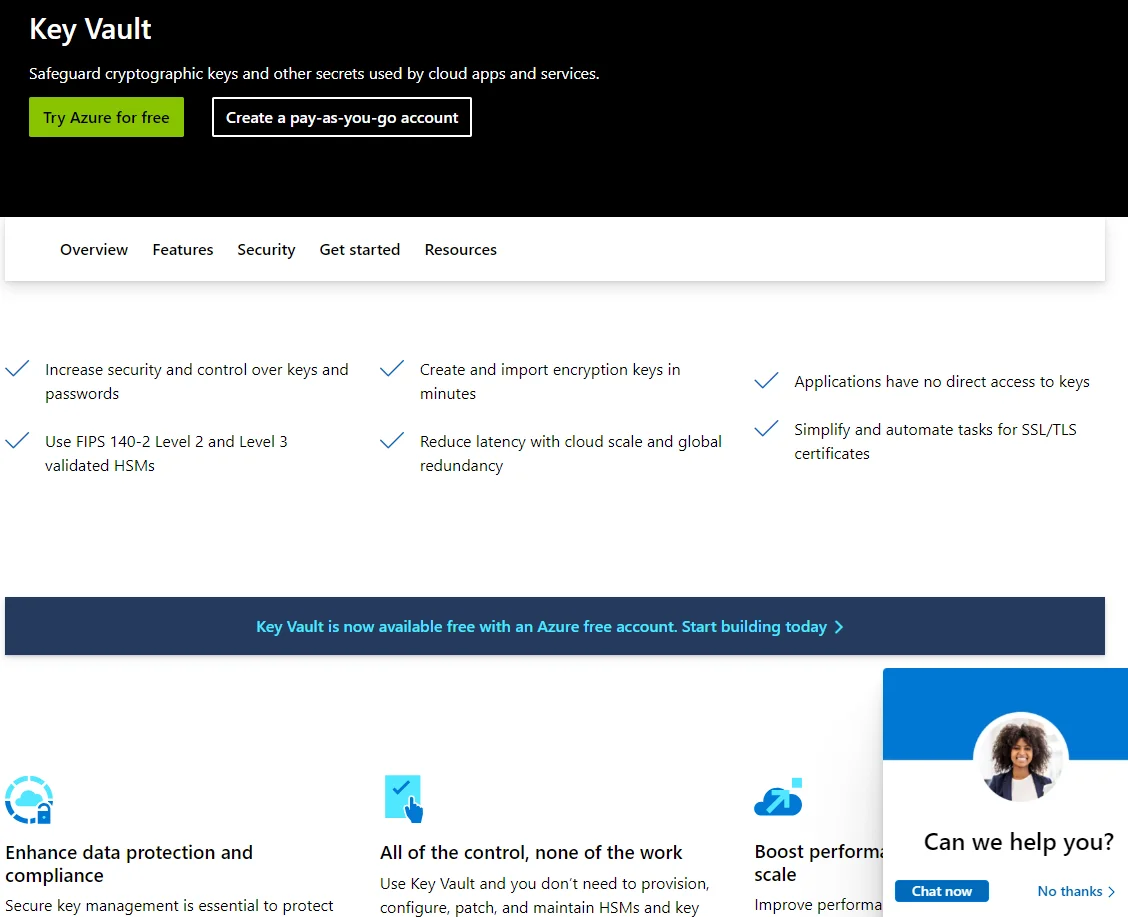
Azure Key Vault is a secure cloud service that helps manage encryption keys, certificates, and secrets.
Features:
- Secure Key Management: Stores and controls access to API keys, passwords, and cryptographic keys.
- Hardware Security Module (HSM) Support: Uses FIPS 140-2 Level 2 validated HSMs for enhanced security.
- Role-Based Access Control (RBAC): Restricts access to sensitive data using Azure AD authentication.
- Automated Certificate Management: Simplifies certificate renewal and lifecycle management.
- Logging & Monitoring: Integrates with Azure Monitor to track and audit access to secrets.
5. Azure Policy
Azure Policy helps enforce governance rules and compliance standards across Azure resources.
Features:
- Governance Automation: Defines policies to enforce security, cost management, and compliance rules.
- Built-In Compliance Controls: Supports regulatory standards like GDPR, HIPAA, and CIS Benchmarks.
- Real-Time Policy Enforcement: Blocks non-compliant deployments before they occur.
- Audit & Reporting: Tracks policy violations and provides insights into compliance status.
- Integration with Azure DevOps: Ensures infrastructure as code (IaC) deployments adhere to security best practices.
Want to enhance security and identity management in your cloud environment? Azure provides comprehensive tools to safeguard your data, applications, and infrastructure.
Monitoring & Debugging Tools
Azure provides powerful monitoring and debugging tools to help you track performance, analyze logs, and detect security threats in real-time. These tools ensure visibility, diagnostics, and troubleshooting across your cloud infrastructure.
1. Azure Monitor
Azure Monitor is a comprehensive monitoring service that collects, analyzes, and visualizes data from Azure resources.
Features:
- Performance Monitoring: Tracks CPU, memory, disk, and network usage.
- Log Analytics: Collects and analyzes logs from Azure services and applications.
- Alerts & Notifications: Sends real-time alerts based on performance thresholds.
- Application Insights Integration: Monitors web applications for latency, errors, and performance issues.
- Dashboard & Reporting: Provides interactive dashboards for data visualization.
2. Azure Application Insights
Azure Application Insights is a performance monitoring tool for web applications that helps you detect and diagnose issues.
Features:
- Request & Response Tracking: Monitors incoming requests and response times.
- Error & Exception Logging: Detects failures in applications and services.
- User Behavior Analysis: Tracks user sessions and interactions.
- Dependency Monitoring: Analyzes external service dependencies like databases and APIs.
- Real-Time Insights: Provides instant feedback on application health.
3. Azure Log Analytics
Azure Log Analytics is a centralized logging tool that collects, analyzes, and visualizes log data from multiple sources.
Features:
- Centralized Log Management: Aggregates logs from Azure VMs, applications, and containers.
- Advanced Querying: Uses Kusto Query Language (KQL) for deep data analysis.
- Security & Compliance Monitoring: Tracks security logs for threat detection.
- Custom Dashboards: Creates visual reports to analyze trends and patterns.
- Integration with Azure Monitor: Works seamlessly with Azure Monitor for full observability.
4. Azure Sentinel

Azure Sentinel is a cloud-native Security Information and Event Management (SIEM) tool that provides AI-driven threat detection and response.
Features:
- Threat Intelligence: Detects security threats using machine learning and AI.
- Automated Threat Response: Uses playbooks to automate security incident response.
- Security Analytics: Analyzes security logs to identify anomalies.
- Integration with Microsoft Defender: Extends security coverage across hybrid environments.
- Compliance Reporting: Helps meet GDPR, HIPAA, and ISO 27001 security standards.
5. Azure Network Watcher
Azure Network Watcher is a network monitoring and diagnostics tool that helps troubleshoot connectivity issues.
Features:
- Packet Capture: Captures network traffic for deep analysis.
- Connection Monitoring: Checks connectivity between Azure resources.
- Topology Mapping: Visualizes network architecture and dependencies.
- Security Group Analysis: Identifies misconfigured network security rules.
- Latency & Throughput Testing: Measures network performance between regions.
Want to enhance monitoring and debugging across your Azure environment? These tools provide real-time insights to help you detect issues and optimize performance.
Hybrid & Multi-Cloud Development Tools
Azure provides powerful hybrid and multi-cloud development tools to help you manage resources seamlessly across on-premises, multi-cloud, and edge environments. These tools ensure flexibility, scalability, and centralized control, enabling you to extend Azure services anywhere.
1. Azure Arc
Azure Arc is a multi-cloud management tool that allows you to manage resources across on-premises, other cloud platforms, and edge environments.
Features:
- Unified Resource Management: Brings on-premises and multi-cloud resources under a single Azure control plane.
- Kubernetes & Server Management: Extends Azure services to Kubernetes clusters and servers, even outside Azure.
- Policy Enforcement: Enables governance and compliance for resources across different environments.
- Security & Identity Integration: Leverages Azure Security Center and Azure Active Directory for secure access.
- Multi-Cloud Support: Works with AWS, Google Cloud, and on-premises data centers.
2. Azure Stack
Azure Stack extends Azure services to on-premises data centers, enabling a consistent cloud experience across hybrid environments.
Features:
- Hybrid Cloud Deployment: Runs Azure services in on-premises data centers.
- Consistent Development & Operations: Uses the same APIs, tools, and security policies as Azure.
- Edge Computing: Deploys cloud applications in remote locations with limited connectivity.
- Compliance & Data Sovereignty: Keeps sensitive data on-premises while benefiting from cloud capabilities.
- Multiple Deployment Models: Includes Azure Stack Hub, Azure Stack HCI, and Azure Stack Edge for different use cases.
3. Azure Lighthouse
Azure Lighthouse is a cross-tenant management solution that allows service providers to manage multiple customer environments from a single control plane.
Features:
- Cross-Tenant Management: Manages multiple Azure subscriptions and tenants from one place.
- Scalability for Service Providers: Allows managed service providers (MSPs) to oversee customer environments efficiently.
- Role-Based Access Control (RBAC): Ensures secure and controlled access to customer resources.
- Automation & Monitoring: Uses Azure Monitor and Azure Security Center for proactive monitoring.
- Seamless Integration: Works with existing Azure services like Azure Policy, Security Center, and Log Analytics.
Looking to streamline hybrid and multi-cloud management? These tools ensure a seamless and secure experience across different environments, making it easier to scale and operate efficiently.
IoT & Edge Computing Tools
Azure offers powerful IoT and edge computing tools that help you securely connect, manage, and analyze IoT devices while bringing cloud services closer to users for real-time processing.
1. Azure IoT Hub
Azure IoT Hub is a fully managed service that allows you to securely connect, monitor, and manage IoT devices at scale.
Features:
- Bi-Directional Communication: Enables secure data exchange between IoT devices and the cloud.
- Device Authentication & Security: Uses per-device security credentials and role-based access control (RBAC).
- Scalability: Supports millions of IoT devices with reliable message routing.
- Integration with Azure Services: Works with Azure Stream Analytics, Azure Machine Learning, and Azure Functions.
- Edge Computing Support: Works with Azure IoT Edge for local data processing.
2. Azure Sphere
Azure Sphere is a comprehensive solution for securing IoT devices with built-in security features.
Features:
- Secure Hardware: Includes a Microsoft-certified microcontroller (MCU) with built-in security.
- End-to-End Security: Protects devices from cyber threats with a secured OS and cloud-based security service.
- Cloud Connectivity: Ensures safe and encrypted communication with Azure IoT Hub.
- Automated Security Updates: Provides over-the-air (OTA) updates for continuous protection.
- Application Control: Restricts device functionality to only approved applications.
3. Azure Digital Twins
Azure Digital Twins is an IoT platform that allows you to model physical environments for smart applications.
Features:
- Real-World Modeling: Creates digital replicas of physical environments such as buildings, factories, and supply chains.
- Graph-Based Modeling: Uses a powerful Digital Twins Definition Language (DTDL) for complex relationships.
- IoT Integration: Connects with Azure IoT Hub to capture real-time device data.
- AI & Analytics: Works with Azure AI to gain insights and automate processes.
- Scalability: Supports large-scale digital twin environments for enterprise solutions.
4. Azure Edge Zones
Azure Edge Zones enable low-latency cloud computing by deploying Azure services closer to users.
Features:
- Ultra-Low Latency: Reduces response times for real-time applications like gaming, IoT, and AI.
- Hybrid Cloud Deployment: Runs workloads on Azure public cloud, private 5G networks, or on-premises.
- Seamless Connectivity: Integrates with Azure Virtual WAN and Azure ExpressRoute for high-speed networking.
- Scalability & Performance: Supports high-performance computing (HPC) and AI-driven edge applications.
- Optimized for IoT & AI: Enhances performance for AI inference and real-time analytics at the edge.
Want to build secure, scalable, and intelligent IoT solutions? These Azure tools empower you to connect devices, process data efficiently, and deploy applications closer to users.
Development & Productivity Tools
Azure provides a range of development and productivity tools to help you build, deploy, and manage applications efficiently.
1. Visual Studio Code (VS Code) with Azure Extensions
Visual Studio Code is a lightweight, open-source code editor with powerful Azure integration through extensions.
Features:
- Azure Extensions: Manage Azure resources directly from VS Code.
- IntelliSense: Provides smart code suggestions for cloud-based development.
- Integrated Terminal: Run Azure CLI commands within VS Code.
- Remote Development: Supports remote debugging and containerized development.
- GitHub Integration: Seamlessly integrates with repositories for DevOps workflows.
2. Visual Studio for Azure
Visual Studio is a full-fledged IDE designed for Azure cloud application development.
Features:
- Azure SDK & Tools: Built-in support for Azure Functions, App Services, and Kubernetes.
- AI-Powered Code Assistance: Helps with smart code completion and debugging.
- Integrated CI/CD: Works with Azure DevOps and GitHub Actions.
- Cloud Debugging: Enables real-time monitoring and debugging of cloud apps.
- Multi-Language Support: Works with C#, Python, JavaScript, and more.
3. Azure Bicep
Azure Bicep is a declarative Infrastructure as Code (IaC) language that simplifies Azure resource deployment.
Features:
- Declarative Syntax: Simplifies complex Azure Resource Manager (ARM) templates.
- Reusable Modules: Enables efficient code structuring for scalable deployments.
- Type Safety & IntelliSense: Provides error checking and autocomplete features.
- Integration with Azure CLI: Deploys infrastructure seamlessly using
az bicep. - Readable & Maintainable: Makes IaC easier to understand compared to JSON-based ARM templates.
4. GitHub Actions for Azure
GitHub Actions for Azure helps automate workflows and deployments directly from GitHub.
Features:
- CI/CD Automation: Automates build, test, and deployment pipelines.
- Prebuilt Azure Actions: Deploys apps to Azure Kubernetes Service (AKS), Functions, and App Services.
- Infrastructure as Code: Works with Terraform, Bicep, and ARM templates.
- Security & Compliance: Enables policy enforcement and secret management using GitHub.
- Multi-Cloud Support: Works with Azure, AWS, and Google Cloud workflows.
5. Terraform on Azure
Terraform is an open-source Infrastructure as Code (IaC) tool for managing cloud resources declaratively.
Features:
- Declarative Configuration: Defines infrastructure using
.tffiles. - State Management: Tracks infrastructure changes with Terraform state.
- Multi-Cloud Support: Manages Azure, AWS, and hybrid cloud environments.
- Automation & Scalability: Automates deployments with Azure DevOps and GitHub Actions.
- Modular & Reusable: Uses Terraform modules to simplify infrastructure management.
Looking to boost productivity and efficiency in your development workflow? These Azure tools help you streamline cloud development, automate deployments, and manage infrastructure effortlessly.
Summary
Azure offers a range of development and productivity tools to enhance cloud-based application development. From VS Code with Azure Extensions for lightweight coding to Visual Studio for full-fledged cloud development, these tools streamline workflows. Azure Bicep and Terraform simplify Infrastructure as Code (IaC), while GitHub Actions for Azure automates CI/CD pipelines. Whether you're building, deploying, or managing cloud applications, these tools improve efficiency.
Want to master Azure AI and cloud computing? Enroll in the Azure AI Engineer Certification Training or start with the Free Azure Fundamentals Course today!
Did You Know? Quiz - Azure Development Tools
Q1: "Azure DevOps is a cloud-based service that provides version control, build automation, and release management."
- True
- False
Q2: "Visual Studio Code is an Azure-based development tool used primarily for managing cloud resources."
- True
- False
Q3: "Azure CLI is a command-line tool used to manage Azure resources programmatically."
- True
- False
Q4: "Azure Functions are used for building microservices and event-driven applications."
- True
- False
Q5: "Azure Resource Manager (ARM) templates allow users to automate infrastructure deployment on Azure."
- True
- False
FAQs
Take our Azure skill challenge to evaluate yourself!

In less than 5 minutes, with our skill challenge, you can identify your knowledge gaps and strengths in a given skill.


